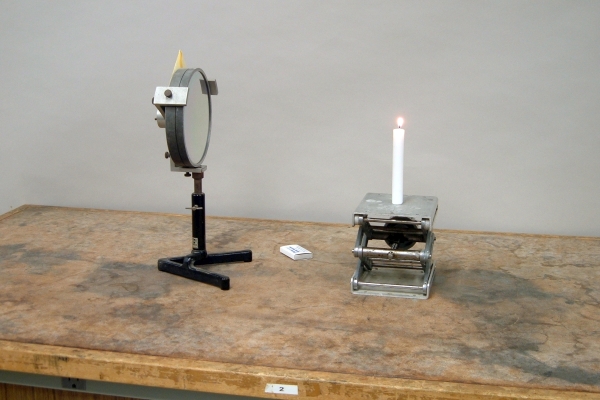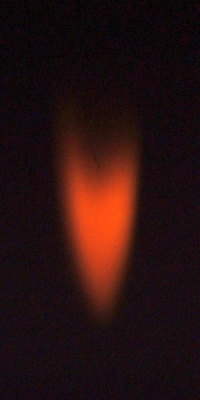 |
 |
 |
 |
When you place a lighted candle at (or very close to) the focal point of the concave mirror, it produces an image of the flame on a distant screen (at “infinity;” that is, the distance to the screen is much, much greater than the focal length of the mirror). A card inside the manilla envelope tucked behind the mirror, has on it the focal length of the mirror, which is ~33.1 cm. This image is real and inverted, as shown at right.
Demonstrations 80.09 – Hinged plane mirrors, and 80.19 – Phantom candle, illustrate the way in which plane mirrors form images of objects placed in front of them. Light that comes from an object to the mirror, is reflected from the mirror in the opposite direction at the same angle at which it arrived at the mirror. That is, its angle of incidence equals its angle of reflection. For a plane mirror, this results in an image of the object appearing behind the mirror at a distance equal to the distance between the object and the mirror. If the mirror is curved, however, this law of reflection has a rather interesting result.
In what follows, we consider a concave spherical mirror, that is, one that has the curvature of the surface of a sphere of radius r, and is curved inward. Our reference line is the axis of the mirror, which is the line that intersects the mirror at the center, perpendicular to any tangent of the surface at that point, which we will call v; it is the vertex of the mirror. Point C, the center of curvature, lies along the axis at a distance r from the mirror. Imagine that we place an object along the axis at point O, some distance outside C. We now imagine a ray going from the object at O, to some point, a, on the mirror surface above the axis. This incident ray makes an angle α at O with respect to the axis, and an angle θ at a, with respect to the radius there. The angle of this radius with respect to the axis is β. The reflected ray makes an angle θ with respect to the radius, and intersects the axis at a point i, somewhere between C and v, where it makes an angle γ with respect to the axis.
As noted in the text below, the conclusions that follow are valid only for O far from v, and for small angles. The angles in the diagram above are drawn for clarity.
These rays and the radius form a set of triangles. Triangle OaCO has angles α, θ and (180 - (α + θ)). The third angle is the supplementary angle to β, and so also equals 180 - β, which means that β = α + θ. Triangle OaIO has angles α, 2θ and (180 - (α + 2θ)). The last angle is the supplementary angle to γ, and so also equals 180 - γ, and we have γ = α + 2θ. Together, these give α + γ = 2β. In terms of the arc av, and the segments vO, vC and vI, in radians, β = av/vC, and for small angles, α ≅ av/vO and γ ≅ av/vI. If we call the object distance, vO, o, and the image distance, vI, i, and note that vC = r, we can rewrite α + γ = 2β as av/o + av/i = 2av/r, or 1/o + 1/i = 2/r. If we set the object at a great distance from the mirror, so that o → ∞ (and the rays coming from it are essentially paraxial), we find that 1/i = 2/r, or i = r/2. r/2 is the focal length of the mirror.
We can also find this focal length by considering a paraxial ray incident on the mirror at some height above the axis. This ray is incident at an angle θ with respect to the radius r at the point where it reaches the mirror. The reflected ray, which goes through the focal point, makes the same angle with respect to the radius, or an angle of 2θ with respect to the incident ray. This angle and the angle at which the reflected ray meets the axis, are alternate interior angles, and are thus congruent. r also makes an angle θ with respect to the axis (it is the alternate interior angle to that of the incident ray with r). h/r = sin θ, and h/f = sin 2θ. For small angles, sin θ ≈ θ, and h ≈ rθ ≈ 2fθ, which gives f = r/2. In the discussion that follows, we will use F to denote the focal point.
As before, this holds only for small angles, and thus for paraxial rays close to the axis.
We can thus also write the equation above as 1/o + 1/i = 1/f. Note the similarity to the thin lens equation. (They are identical.) Note also that sign conventions vary for the terms in this equation.
If we place an object outside both F and C, it produces a real, inverted image somewhere between F and C. The image is smaller than the object, by the ratio of their respective distances from the mirror. That is, if the object is four times as far from the mirror as the image, the image is one-fourth its size. We can see this by choosing a point on the object away from the axis, and from there tracing a paraxial ray, a ray that passes through F, and one that goes through C (that is, along a radius of the mirror). After reflection, these rays all meet at a point between F and C, where an image forms. The magnification is the ratio of the distance from the axis to this point and the distance from the axis to the corresponding point on the object, which, as noted above, equals the ratio of the image distance to the object distance, or -i/o (negative because the image is inverted). If we move the object closer to the mirror, as it approaches C, the image point moves outward. When the object is at C, the image, still real and inverted, but now equal in size to the object, appears at C. (See demonstration 80.15 -- Phantom light bulb.)
If we place the object at a great distance from the mirror – at “infinity” (o ≫ f), a real, inverted image forms at F, greatly reduced in size compared to the object.
If we place the object between C and F, it forms an image outside C, which is real, inverted and enlarged. We consider three rays going from the object to the mirror – a paraxial ray, one going through F, and one that goes along the line that passes through C (a radius). The reflection from the paraxial ray goes through F, and the reflection of the ray coming through F returns paraxial. The ray that lies on the radius reflects back on itself and passes through C. The three reflected rays meet somewhere outside C. The image is inverted, and since i is now greater than o, it is enlarged.
If we place the object inside F, an image forms behind the mirror. This image is virtual and erect. We consider three rays leaving the top of the object – one paraxial, one that goes along the line from F, and one that goes along the line from C (a radius). The reflected paraxial ray goes through F. The ray on the line from F is reflected paraxially. The ray that goes along a radius is reflected back on itself through C. All of these reflected rays intersect behind the mirror, to form a virtual, erect image that is larger than the object. This is, in fact, how magnifying mirrors work.
Last but not least, we come to the situation that holds for this demonstration – the object is placed at F. In this case, a real, inverted image forms at a great distance from the mirror, essentially at “infinity.” A ray from a point on the object, traveling along the line that goes through C (a radius) reflects back along itself, through C. A paraxial ray from the same point on the object reflects from the mirror to go through F, parallel to the first ray. It may seem odd that such rays should form an image, but these rays take the reverse path that rays from a distant object would take to form an image at F. The photograph above, at right, is the inverted image of a candle flame, on a screen that was approximately nine meters away from the mirror, or a distance of around 27 times its focal length.
References:
1) Resnick, Robert and Halliday, David. Physics, Part Two, Third Edition (New York: John Wiley and Sons, 1977), pp. 963-8.
2) http://hyperphysics.phy-astr.gsu.edu/hbase/geoopt/mirray.html#c3 and links to related topics.